

Company Behind DAPL Reported 69 Accidents, Polluted Rivers in 4 States in Only 2 Years. Although it obstinately insists pipelines are safe, the company responsible for the Dakota Access Pipeline racked up 69 reported accidents in just two years — leaking hundreds of thousands of gallons of oil products and tainting rivers in four states.
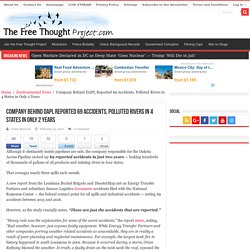
That averages nearly three spills each month. A new report from the Louisiana Bucket Brigade and DisasterMap.net on Energy Transfer Partners and subsidiary Sunoco Logistics documents accidents filed with the National Response Center — the federal contact point for oil spills and industrial accidents — noting 69 accidents between 2015 and 2016. Uncontrollable Gas Leaks In Texas Top California’s Leak, So Why Haven’t We Heard About It? Texas gas leaks are worse than the California leak and show no sign of stopping.
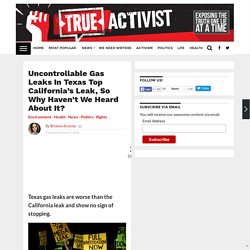
Credit: Inhabitat The short answer to the question in the headline, and most other similar questions in America, is that big money doesn’t want you to hear about it, so you won’t. The devastating methane gas leak that tormented citizens of Aliso Canyon in California displaced nearly 3,000 households and relocated children so they could attend different schools. The leak was officially capped last month and residents were able to return to their homes, where they have memories of the nose bleeds, headaches, stomach aches, vomiting and much more caused by the methane and its additives. The additives consisted of benzene, nitrogen oxides and sulfur-like compounds. At its peak, the California leak was measured at 58,000 kilograms per hour. A study conducted by the Weather Channel, the Center for Public Integrity and InsideClimate News resulted in a resounding statement where they stated that they found, What’s Going On Health-Wise From LA’s Methane Leak Problems? Catherine J.
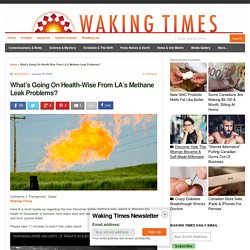
Frompovich, GuestWaking Times Here is a short heads-up regarding the San Fernando Valley methane leak, which is affecting the health of thousands of humans from radon dust and radiation damage, plus other aerosolized toxins and toxic ground water. Please take 11 minutes to watch this video report: The current acute problem has been ongoing since October 2015 but, actually, was put into place years ago with the irresponsible disposal of nuclear waste from nuclear power plants. And they tell us nuclear power is safe when you can’t dispose SAFELY of its waste products! Take note of 6:20 minutes to the end on the timeline. That once beautiful state that people flocked to apparently is not faring very well.
Seemingly everyone, including pets and animals, are being affected negatively: losing health, property values and probably homes to live in. Another pointed question that has to be asked is: “How is all that toxic material affecting the food and produce grown in California?” 5 Years Since Massive Tar Sands Oil Spill, Kalamazoo River Still Not Clean. Five years ago today, in the middle of the night, an oil pipeline operated by Enbridge ruptured outside of Marshall, Michigan.
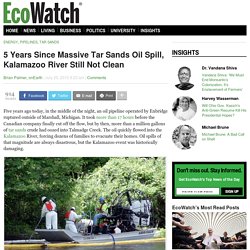
It took more than 17 hours before the Canadian company finally cut off the flow, but by then, more than a million gallons of tar sands crude had oozed into Talmadge Creek. The oil quickly flowed into the Kalamazoo River, forcing dozens of families to evacuate their homes. Oil spills of that magnitude are always disastrous, but the Kalamazoo event was historically damaging. The first challenge was the composition of the oil. Fresh tar sands crude looks more like dirt than conventional crude—it’s far too thick to travel through a pipeline.
To get this crumbly mess to flow, producers thin it out with the liquid constituents of natural gas. When dilbit gushed into Talmadge Creek in 2010, the mixture broke apart. The tar sands oil, which stayed in the water, presented an even bigger chemistry problem. Tar sands crude behaves differently. Rights groups sue Gulf oil company - National Human Rights. Environmental and human rights watchdog group Louisiana Environmental Action Network (LEAN), its Lower Mississippi Riverkeeper program, Waterkeeper Alliance and several Gulf Coast Waterkeeper organizations filed suit in Federal Court today, February 2, 2012, against New Orleans-based Taylor Energy Co., LLC. under the citizen suit provisions of the Clean Water Act and Resource Conservation Recovery Act, for ongoing violations from an ongoing seven year oil spill in the Gulf of Mexico.

Rights groups sue Gulf oil company - National Human Rights. Secret Videos Expose Chevron's Corruption in Ecuadorian Oil Spill. There’s a new development in the case against Chevron for its failure to address decades of contamination in the Ecuadorian Amazon.
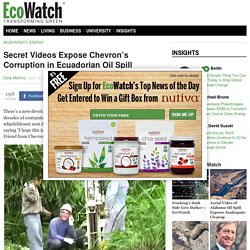
An apparent Chevron whistleblower sent dozens of internal company videos to Amazon Watch with a note saying “I hope this is useful for you in your trial against Texaco/Chevron. [signed] A Friend from Chevron.” The videos—some of which can be seen on Amazon Watch—show Chevron employees and consultants secretly visiting the company’s former well sites in Ecuador to find samples that didn’t contain crude oil to use in soil and water samples at later site inspections when the presiding trial judge would be there to monitor the testing.
The problem is that they couldn’t do it. In the videos, the employees can be heard joking about how they just can’t find a sample without crude oil in it.